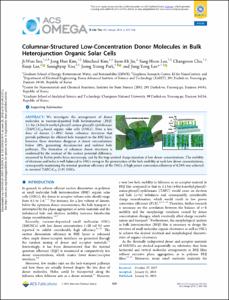GIST Repository
College of Engineering
Department of Materials Science and Engineering
1. Journal Articles
Columnar-Structured Low-Concentration Donor Molecules in Bulk Heterojunction Organic Solar Cells
- Type
- Article
- Citation
- ACS OMEGA, v.3, no.1, pp.929 - 936
- Issued Date
- 2018-01
- Abstract
- We investigate the arrangement of donor molecules in vacuum-deposited bulk heterojunction (BHJ) 1,1-bis-(4-bis(4-methyl-phenyl)-amino-phenyl)-cyclohexane (TAPC):C70-based organic solar cells (OSCs). Even a low dose of donors (∼10%) forms columnar structures that provide pathways for efficient hole transport in the BHJ layer; however, these structures disappear at donor concentrations below 10%, generating disconnected and isolated hole pathways. The formation of columnar donor structures is confirmed by the contrast of the contact potential difference, measured by Kelvin probe force microscopy, and by the trap-assisted charge injection at low donor concentrations. The mobility of electrons and holes is well balanced in OSCs owing to the preservation of the hole mobility at such low donor concentrations, consequently maximizing the internal quantum efficiency of the OSCs. A high power conversion efficiency of 6.24% was achieved in inverted TAPC:C70 (1:9) OSCs.
- Publisher
- 1155 16TH ST, NW, WASHINGTON, USA, DC, 20036
- ISSN
- 2470-1343
- Appears in Collections:
- Department of Materials Science and Engineering > 1. Journal Articles
- 파일 목록
-
-
Download
 acsomega _columnar structure SCI X 2018.1.24 ESCI.pdf
기타 데이터 / 4.87 MB / Adobe PDF
acsomega _columnar structure SCI X 2018.1.24 ESCI.pdf
기타 데이터 / 4.87 MB / Adobe PDF
-
Items in Repository are protected by copyright, with all rights reserved, unless otherwise indicated.